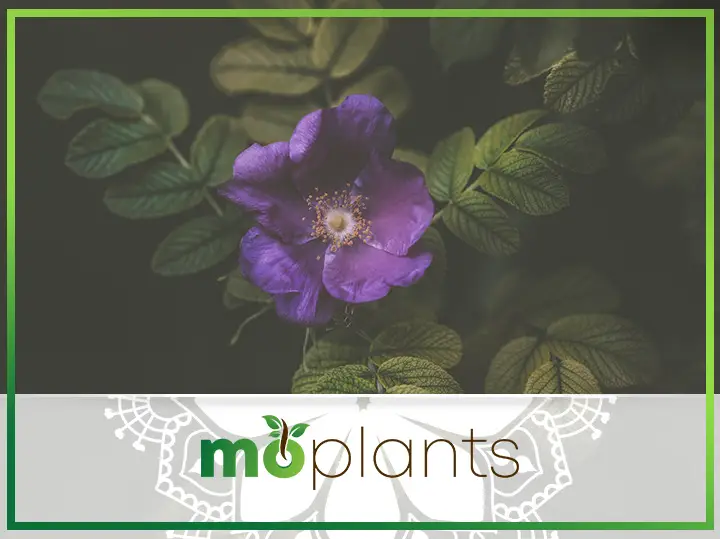The breathtakingly beautiful blossoms and vibrant foliage of African violet have made it one of the most popular houseplants worldwide. These exotic beauties are available in hundreds of varieties and hybrids featuring a multitude of leaf forms and hues. The characteristics and colors of its flowers also vary with each type, ranging from shades of white and pink to lavender and burgundy.
This gorgeous flowering plant is native to higher elevations in East Africa. However, it is grown worldwide due to its charming appearance and relatively low-maintenance nature. Although it has some quirks, growing African violet indoors is not difficult. Even if you are a beginner who has never taken care of a plant before, there’s no need to be intimidated by this tropical houseplant. As long as it receives adequate water, light, and fertilizer, your African violets will continue to flourish.
Under the right growing conditions, an African violet plant can produce flowers all around the year. It also has a lifespan of about 50 years.
You can grow African violet on your windowsill or in an indoor garden to add a pop of color and brightness to your surroundings.
Introduction: African Violet
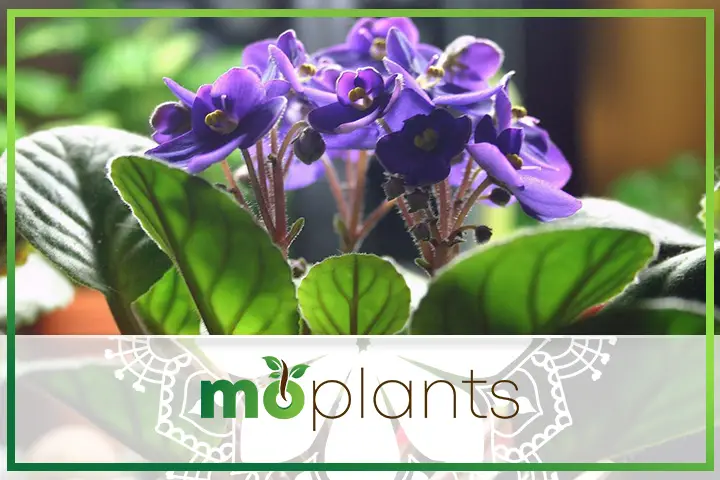
The botanical name of African violet is Saintpaulia ionantha, and it belongs to the Gesneriaceae family.
It was named after Baron Walter von Saint, a colonial official stationed in Africa who sent specimens of these plants from Tanzania to his family in Germany back in the late 1800s. Little did he know, these exotic plants would turn out to be a hit among plant lovers and become one of the must-have houseplants in Europe.
In the 1920s, these plants became popular in the United States after a California grower introduced new hybrids of African violets in the market.
This tropical beauty has a total of nine species, eight subspecies, and more than 16,000 cultivars. While each of these variations features unique leaves and flowers, they are usually classified according to their size. The miniature variety is less than 8 inches wide and produces flowers that measure 0.75 inches across. On the other hand, the standard type grows between 8 and 16 inches wide with flowers 2 inches wide. Meanwhile, the large plants are more than 16 inches wide and bear 3-inch flowers.
African violets feature fuzzy leaves that grow in a rosette form and produce clusters of single, double, or semi-double flowers with ringed or ruffled petals. These flowers may appear in the lighter hues of white and pink or in the deeper shades of lavender, blue-red, purple, magenta, burgundy, or crimson. Some African violet varieties bear variegated foliage and bi-colored flowers as well.
Contrary to popular belief, this houseplant is neither high-maintenance nor dramatic. If you want your African violet plant to bloom continuously, you must find the right balance of light, temperature, air, and water for it to thrive.
It is also important to point out that these plants flourish in average home environments and do not require constant care.
How to Grow African Violet
Here are some tips on how to grow African violet plants indoors that you may find helpful.
Placement
You can place your African violets near any window that receives bright sunlight. Usually, these plants do well in north and south-facing windows as long as trees do not block their light. If the window receives too much direct sunlight, you can hang sheer curtains to protect the foliage from burning. Meanwhile, the east and west-facing windows are a good option for African violets during the winter months.
Pro Tip: Place your houseplant about three feet away from the window for sufficient lighting and a fresh breeze.
Ideal Temperature
The ideal temperature to grow African violets indoors is 70 degrees Fahrenheit. Slight variations in the temperature between day and night-time won’t affect the growth of your houseplant. However, do not allow the temperature to rise above 80 degrees or fall below 60 degrees Fahrenheit. Exposure to extreme fluctuations, even for a short time, can be hazardous for this tropical plant.
Humidity Level
Being native to tropical East Africa, these attractive plants prefer highly humid conditions. Nonetheless, since an average home cannot maintain 70% to 80% humidity at all times, you must make sure the humidity level in your house is between 50% and 60% at the very least.
Those who live in drier areas can buy a humidifier to ensure their African violet’s transpiration rate does not exceed its ability to absorb water.
Exposure to Light
African violets require around eight hours of bright and indirect sunlight to bloom and remain healthy. If that’s not possible, consider placing your plant under a fluorescent light inside your home.
The plants with dark green foliage need a higher light intensity than those with pale or lighter leaves. So, it may be good to adjust the brightness accordingly.
Watering Frequency
It would be best if you watered African violets once a month.
Since this plant prefers moist soil, you can touch the top of the potting media to determine if it needs to be watered. If the soil feels dry, water the African violet plant at the base with lukewarm or tepid water. Be careful not to splash the water on the foliage, resulting in foliar spots and damaging the leaves. Moreover, please make sure not to overwater the plant or let it sit in water.
The best way to water African violets is by inserting the spout into the soil. You can completely flush the soil and discard the excess water to eliminate any mineral buildup every couple of months.
Potting Mix
A well-drained potting mix is mandatory to grow African violet plants indoors. You can either buy a special mix from a local nursery or make your own by mixing equal parts perlite, peat moss, and vermiculite. Please remember that soil with poor drainage can result in root rot, ultimately killing the plant.
Infographic
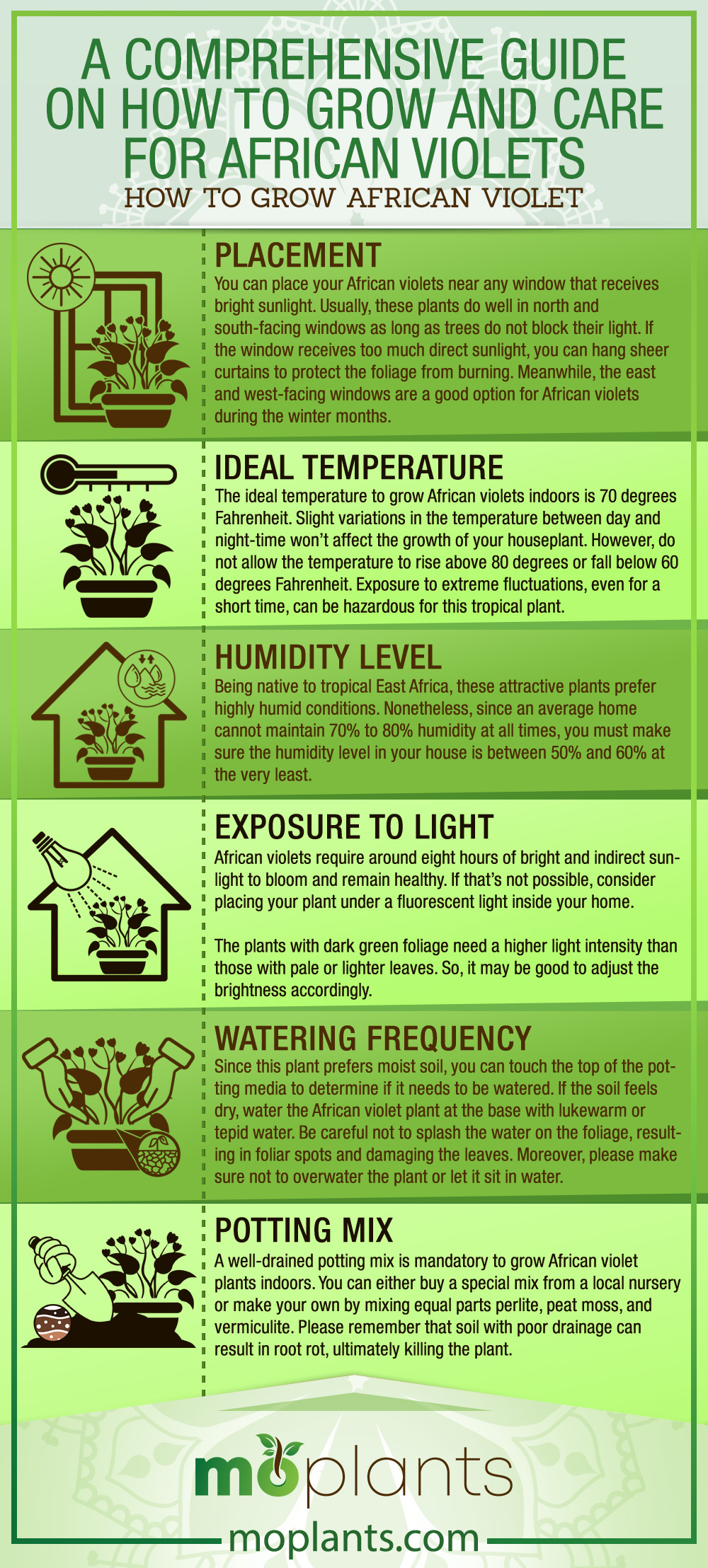
African Violet Propagation Method
African violets are rather easy to propagate. Whether you want to expand your plant collection or gift it to a friend, you can use leaf cuttings to grow a new plant.
For African violet propagation, choose a mature leaf from the middle of the plant and cut it with a sterile knife along with 1.5 inches of the stem. Then, you can insert the stem into a fresh potting media and place it in a bright spot in your home. It is also important to keep the soil moist. In a little over a month, you will be able to see baby plants forming at the base of the cutting.
Once the plant has sprouted at least four leaves, you can carefully separate them from the cutting and plant them in different pots. However, you must make sure to keep their tiny roots intact as you move them.
African Violet Care Tips
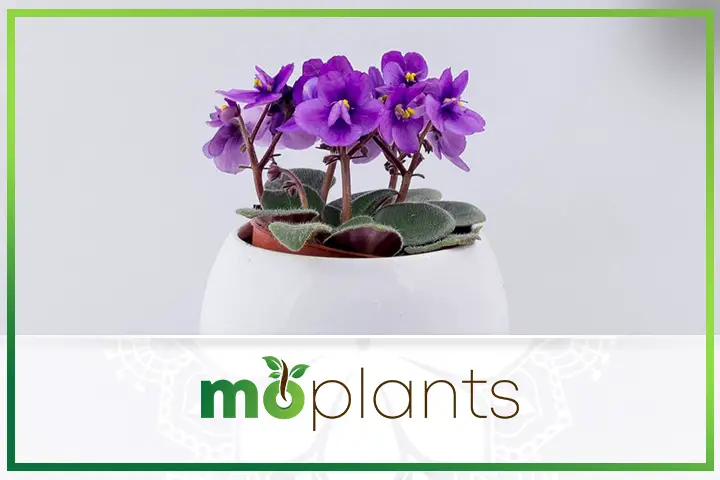
Let’s look at some essential African violet care tips to make growing these plants much less intimidating.
Pruning and Trimming
It is vital to remove dead flowers and leaves from the plant to encourage new growth. You should also remove any dead leaves or petals that may have fallen on the soil to prevent root rot. Regular pruning with a pair of clean tweezers will allow your African violet plant to remain fresh and healthy for a long time.
Cleaning and Wiping
Since you shouldn’t wash the foliage of your African violets with water regularly, consider removing the dust, dirt, and other debris off the leaves with a soft, dry paintbrush. Alternatively, you can gently wipe the leaves with a soft cloth.
Fertilizer
You can feed your African violets with a mild fertilizer every week or so for optimal growth. Don’t forget to moisten the soil before adding the recommended amount of fertilizer. It will help prevent the roots from burning. In addition, discard the excess water and fertilizer immediately.
This African violet care tip can add several years to your plant’s life.
Repotting
African violets tend to bloom when they are slightly pot-bound. However, you should ideally repot the plant when the spread of its leaf span becomes almost double the pot diameter. Also, please note that moving your plant to a larger pot can delay the bloom.
Choosing Containers
Most home gardeners prefer terracotta or plastic pots to grow African violet plants. While both of these options are fine, it is important to know that plastic pots are easier to clean and they retain moisture for a long time. Meanwhile, terracotta pots can absorb the moisture from the soil, drying it out fairly quickly.
Are African Violets Toxic?
African violets are not only a sight for sore eyes, but they are also perfectly safe for humans and animals alike. These tropical plants don’t pose any danger to your furry companions unless ingested in large quantities, which may result in stomach aches.
Common African Violet Problems and How to Solve Them
These are some of the most common problems you may face while growing African violets indoors.
Lack of Flowers
If your African violet plant isn’t blooming and its leaves have become narrow, it is an indication that your houseplant is not receiving sufficient sunlight.
The best way to counter this problem is to move the plant to a brighter location in your home and increase the temperature to 70 degrees Fahrenheit. You should try and maintain this temperature throughout the night as well.
Pale or Discolored Leaves
The leaves of this tropical beauty may appear pale or bleached out if you leave them under direct sunlight for prolonged hours. Since African violets prefer bright yet indirect sunlight, consider relocating the plant to a spot that doesn’t receive intense light.
Limp or Wilted Plant
Overwatering and poor drainage are the leading causes of limp and wilted plants. If the roots don’t get a chance to dry between watering, they can develop root rot, which may eventually kill the plant.
However, to prevent that from happening, make sure to check the roots of your plant. Unless they have turned completely soft and mushy, please repot your African violets in a new container with an adequate drainage hole. Choosing well-drained soil can also help bring your plant back to life.
Slow Growth
Nutrient deficiency and lack of fertilizer can stunt the growth of your African violets. So, if you have noticed the foliage losing its colors or lack of new growth, consider fertilizing your plant every week or as per the manufacturer’s instructions.
Rusty Leaves
If the leaves of your houseplant have adopted a rust-colored hue, it may be a sign of over-fertilization. To restore the foliage to its original color, flush the plant with plain water to remove fertilizer buildup.
Common Pests and Diseases
African violets are vulnerable to mealybugs, thrips, and cyclamen mites. If your plant has become infested, please make sure to separate it from the rest of your collection to avoid the pests from spreading. Next, take a cotton swab and soak it in 70% isopropyl alcohol. You can use this swab to rub off the bugs and remove as many of them as possible. You should also rinse the plant with plain water and blot it dry.
To ensure your African violets remain healthy, repeat this procedure each day until the foliage becomes clean and pest-free.
Infographic

Popular African Violet Varieties
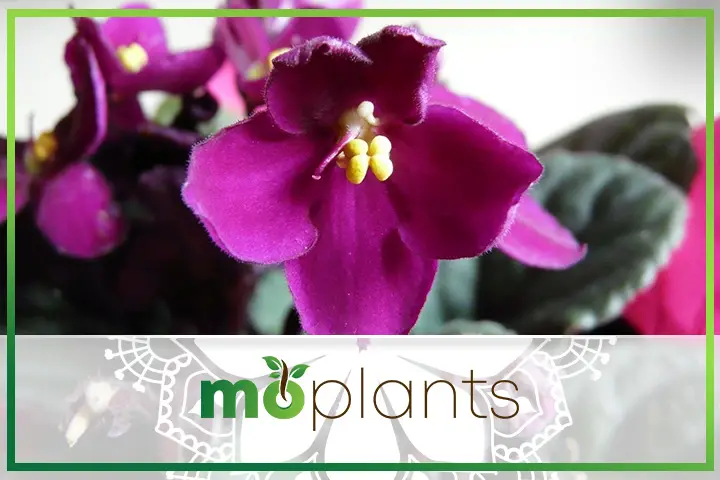
There are hundreds of African violet varieties available in nurseries and online stores all across the country. These hybrids come in unique shapes and sizes, adding an element of interest to your interior design.
Here are some of the most well-known African violet varieties that you must know about.
Summer Twilight
The remarkable Summer Twilight plant is a popular variant of African violets. It has lively foliage and produces stunning purple flowers decorated with a white outline. The bright yellow center of the flower also accentuates its beauty, making Summer Twilight a wonderful addition to any home.
Gold of Scythians
This plant produces elegant white blooms tinged with soft pink hues and a yellow center. The aesthetically pleasing Gold of Scythians is easy to grow and look after. You can place it near a window in your bedroom, living room, or hallway to freshen up the space.
Lonestar Twilight
It is yet another beloved variation of African violets. This plant is known for its white flowers that stand out from the rest due to their rich, violet edges. The center of the flower is yellow, adding a beautiful accent to the plant. You can either display it in your home or gift it to a loved one to mark a special occasion.
Aroma of Summer
As the name suggests, the Aroma of Summer is a highly fragrant plant that can brighten up your home with its bright pink blooms. The eye-catching flowers feature a white tint and a yellow center, which create a beautiful contrast against the green foliage. It is the perfect plant to grow indoors if you want to add some color to your home décor.
Diamond Tiffany
This delicate and precious variety of African violets feature ruffled flowers with yellowish-white and light green hues. A Diamond Tiffany plant can be a perfect addition to contemporary or minimalist décor.
African Violet FAQs
Here are some of the most frequently asked questions about African violets.
How long does an African violet plant live?
If treated with care and affection, an African violet plant can live up to 50 years. The best way to increase its lifespan when grown indoors is to keep it in a bright spot and only water it once the soil dries out completely.
Is it allowed to mist an African violet plant?
African violets flourish in high humidity. Nevertheless, if your indoor air is very dry, you can mist your plant regularly using room temperature water. Also, refrain from misting the foliage in the evening or at night.
Are coffee grounds good for African violets?
Yes, you can use coffee grounds to fertilize African violets. For a better result, mix the dried coffee grounds with dried eggshells and add them to the soil. Repeat the process every couple of months to keep the plant healthy.
To summarize, African violet is one of the best plants you can grow indoors. Contrary to popular opinion, this exotic beauty only requires minimal upkeep and attention. All you need to do is place it in a nice and bright spot to receive fresh air and indirect light.

